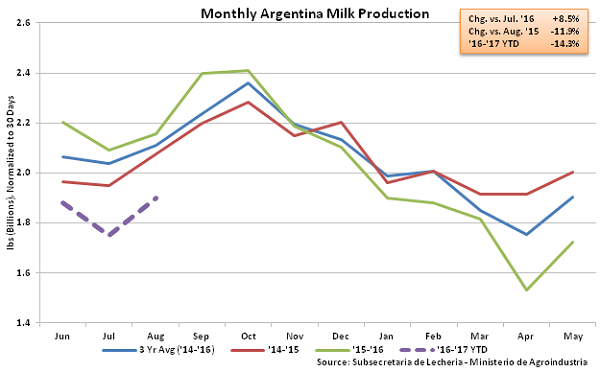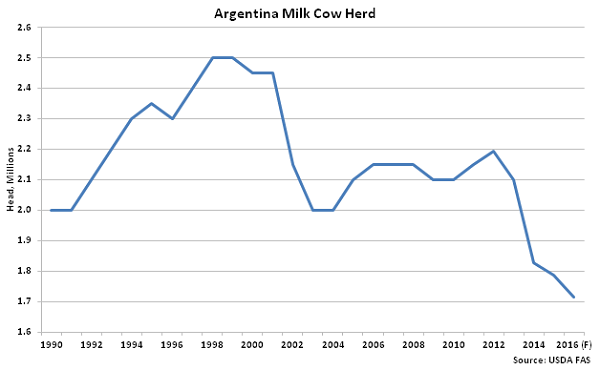Quarterly Argentina Milk Production Update – Oct ’16
Executive Summary
Argentine milk production figures provided by the Argentina Ministry of Agriculture were recently updated with values spanning through the first quarter of the ’16-’17 production season. Highlights from the updated report include:
• Argentine milk production remained lower on a YOY basis for the ninth consecutive month during Aug ’16, finishing down 11.9%. Low profit margins, poor weather, high inflation and increased production costs have contributed to the recently experienced declines in production.
• Recently experienced adverse conditions are expected to contribute to the Argentine dairy cow herd contracting by 4.0% in total throughout 2016. The YOY decline in the Argentine dairy cow herd would be the fourth experienced in a row.
• Argentina is the fifth largest global dairy exporter, accounting for 3.7% of combined butter, cheese, nonfat dry milk and whole milk powder exports throughout 2015. The bulk of Argentine dairy exports are in the form of cheese and whole milk powder.
Additional Report Details
According to the Argentina Ministry of Agriculture, Aug ’16 Argentine milk production declined by 11.9% YOY, finishing at a seven year low for the month of August. Argentine milk production has declined on a YOY basis over nine consecutive months through August. Argentine milk production finished the ’15-’16 production season down 0.9% as volumes declined 8.7% throughout the second half of the season. Production is down an additional 14.3% throughout the first quarter of the ’16-’17 production season.
 Low farmgate milk prices, poor weather, high inflation and increased production costs have taken a toll on producers over recent month, contributing to recent declines in production. According to USDA, corn prices within Argentina have increased by nearly 80% throughout the first half of 2016 due to the removal of export controls and the devaluation of the peso. In addition, floods generated by a strong El Niño have affected major milk producing areas.
Low farmgate milk prices, poor weather, high inflation and increased production costs have taken a toll on producers over recent month, contributing to recent declines in production. According to USDA, corn prices within Argentina have increased by nearly 80% throughout the first half of 2016 due to the removal of export controls and the devaluation of the peso. In addition, floods generated by a strong El Niño have affected major milk producing areas.
 Recently experienced adverse conditions are expected to contribute to the Argentine dairy cow herd contracting by 4.0% throughout 2016, to 1.72 million head, the lowest figure on record. The YOY decline in the Argentine dairy cow herd would be the fourth experienced in a row.
Recently experienced adverse conditions are expected to contribute to the Argentine dairy cow herd contracting by 4.0% throughout 2016, to 1.72 million head, the lowest figure on record. The YOY decline in the Argentine dairy cow herd would be the fourth experienced in a row.
 Argentina is the second largest milk producing country in South American, trailing only Brazil, and the fifth largest global dairy exporter, trailing only New Zealand, the EU-28, the U.S. and Australia. Of the aforementioned major dairy exporting regions, Argentina accounts for 4.0% of total combined milk production and 3.7% of combined cheese, whole milk powder (WMP), butter and nonfat dry milk (NFDM) export volumes.
Argentina is the second largest milk producing country in South American, trailing only Brazil, and the fifth largest global dairy exporter, trailing only New Zealand, the EU-28, the U.S. and Australia. Of the aforementioned major dairy exporting regions, Argentina accounts for 4.0% of total combined milk production and 3.7% of combined cheese, whole milk powder (WMP), butter and nonfat dry milk (NFDM) export volumes.
 The bulk of Argentine dairy exports are in the form of cheese and WMP. Argentina was the third largest exporter of WMP throughout 2015, trailing only New Zealand and the EU-28, accounting for 6.2% of global WMP export volumes. From a global perspective, WMP markets may be most affected by a continued decline in Argentine milk production.
The bulk of Argentine dairy exports are in the form of cheese and WMP. Argentina was the third largest exporter of WMP throughout 2015, trailing only New Zealand and the EU-28, accounting for 6.2% of global WMP export volumes. From a global perspective, WMP markets may be most affected by a continued decline in Argentine milk production.

 Low farmgate milk prices, poor weather, high inflation and increased production costs have taken a toll on producers over recent month, contributing to recent declines in production. According to USDA, corn prices within Argentina have increased by nearly 80% throughout the first half of 2016 due to the removal of export controls and the devaluation of the peso. In addition, floods generated by a strong El Niño have affected major milk producing areas.
Low farmgate milk prices, poor weather, high inflation and increased production costs have taken a toll on producers over recent month, contributing to recent declines in production. According to USDA, corn prices within Argentina have increased by nearly 80% throughout the first half of 2016 due to the removal of export controls and the devaluation of the peso. In addition, floods generated by a strong El Niño have affected major milk producing areas.
 Recently experienced adverse conditions are expected to contribute to the Argentine dairy cow herd contracting by 4.0% throughout 2016, to 1.72 million head, the lowest figure on record. The YOY decline in the Argentine dairy cow herd would be the fourth experienced in a row.
Recently experienced adverse conditions are expected to contribute to the Argentine dairy cow herd contracting by 4.0% throughout 2016, to 1.72 million head, the lowest figure on record. The YOY decline in the Argentine dairy cow herd would be the fourth experienced in a row.
 Argentina is the second largest milk producing country in South American, trailing only Brazil, and the fifth largest global dairy exporter, trailing only New Zealand, the EU-28, the U.S. and Australia. Of the aforementioned major dairy exporting regions, Argentina accounts for 4.0% of total combined milk production and 3.7% of combined cheese, whole milk powder (WMP), butter and nonfat dry milk (NFDM) export volumes.
Argentina is the second largest milk producing country in South American, trailing only Brazil, and the fifth largest global dairy exporter, trailing only New Zealand, the EU-28, the U.S. and Australia. Of the aforementioned major dairy exporting regions, Argentina accounts for 4.0% of total combined milk production and 3.7% of combined cheese, whole milk powder (WMP), butter and nonfat dry milk (NFDM) export volumes.
 The bulk of Argentine dairy exports are in the form of cheese and WMP. Argentina was the third largest exporter of WMP throughout 2015, trailing only New Zealand and the EU-28, accounting for 6.2% of global WMP export volumes. From a global perspective, WMP markets may be most affected by a continued decline in Argentine milk production.
The bulk of Argentine dairy exports are in the form of cheese and WMP. Argentina was the third largest exporter of WMP throughout 2015, trailing only New Zealand and the EU-28, accounting for 6.2% of global WMP export volumes. From a global perspective, WMP markets may be most affected by a continued decline in Argentine milk production.
